Posts Tagged ‘Comics Time’
Comics Time: Multiforce
December 7, 2009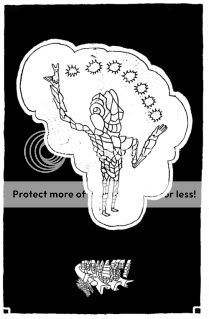
Multiforce
Mat Brinkman, writer/artist
PictureBox, 2009
22 pages
$15
We tend to think of the breakdown of civilization as a rather stark affair. Things fall apart, the center cannot hold, and before long everything’s a burnt-out husk and people in rags and/or leather underpants are scavenging the wasteland for canned peaches and guzzoline. In keeping with Fort Thunder’s general aesthetic project of information overload, Multiforce imagines the contrary: a replete Ragnarok, a jam-packed apocalypse.
A loosely linked narrative about the warring citizens of a massive mountain redoubt called Citadel City and the even stranger places above and below it, Multiforce‘s serialized strips (they originally appeared in Providence’s visual-noise bible Paper Rodeo) concern themselves primarily with bigness. A giant meets an even bigger giant, who meets an even bigger dragon; little dudes ride around inside the head of a huge dude; skeletal characters dwell in structures and even cities that are shaped like their own skulls, suggesting a preexisting being of almost unimaginable proportions. Half of the book’s narrative juice comes simply from stringing the book’s two protagonists (and the reader) along until the next massive step-up in scale can be revealed. It’s like the comics equivalent of a zoom-out, only suggested through sequential juxtaposition rather than an actual ratcheting back of the viewing plane (that actual technique is seldom if ever used here, to the best of my recollection).
The creatures, which are as gorgeous and inventive and inner-eight-year-old awesome as you’d expect from the product of a man who nowadays makes a living by creating prints of demons and shit, are a constant game of one-upsmanship as well. Brinkman lays this out in an introductory strip, in which we watch a monstrous character who’s super-proud of his awesomely dangerous bionic arm–“I HAVE THE MOST ULTRA ARM IN THE UNIVERSE”–promptly get his clock cleaned by the book’s main, inscrutable antagonist, Battlemax Ace. He’s a battle beast with an axe for one hand and a mace for the other. Yeah, it’s that kinda book. And it’s Battlemax Ace’s unstoppable rampage that brings Citadel City crashing down and provides one of the book’s few genuine narrative and logistical throughlines as he smashes his way through opponent after opponent and level after level. His awesomeness is too powerful to contain.
In many ways these beasties and their navigation of craggy subterranean spaces recalls Brinkman’s landmark collection Teratoid Heights, but that book’s wordless fervor gives way to Brinkman’s loosey-goosey verbal hijinx–his characters bumble around and talk smack like a crudely lettered cross between the Muppets and the stars of a stoner comedy. So the moments of sheer visual poetry stand out in even starker relief–our heroes flying in a sinuous, continuous curve through a Marc Bell riot of a carnival; a dropped head bouncing and rolling down a massive page-tall mountainside; the aforementioned giant skull. But the main takeaway is a set of civilizations so obliviously concerned with their own business and jaded about their potential annihilation that they’re all pretty much fiddling as Citadel City and its environs burn (and explode and implode and collapse and cave in and get smashed by Battlemax Ace and so on). Our heroes even leaven their soaring last-page getaway with a snort of “yea right.” One, two, three, what are they fightin’ for? Don’t ask ’em, they don’t give a damn.
Comics Time: Split Lip Vol. 1
December 4, 2009
Split Lip Vol. 1
Sam Costello, writer
Josh Bivens, Diego Candia, Gary Crutchley, Nelson Evergreen, Ayhan Hayrula, Brian A. Laframboise, Iain Laurie, Sami Makkonen, Brian McGleenon, Felipe Sobreiro, Kyle Strahm, artists
Tent City, 2009
158 pages
$15
Read it and buy it at SplitLipComic.com
The back cover of this collection of astute horror writer and critic Sam Costello’s anthology webcomic reads in part, “Split Lip sheds traditional horror archetypes in favor of creating dark moods, original characters, and frightening experiences.” Of the three claims I think the first is the best supported. Somber and stark in almost every particular, from plotting to dialogue to his army of collaborators’ art, Costello’s comics quietly but relentlessly reinforce the simple fact that horror is about death. There’s a funereal sadness even in the less effective pieces here, a sense that the horror Costello’s interested in stems not so much from fright as from pessimism. After all, we’re all headed for our own down endings. So to me this offsets the lack of bona fide “frightening experiences”; contra the back cover blurb, I don’t even think that’s what these comics were even going for.
That said, the individual stories vary wildly not so much in quality–I never though “man, this is junk”–as in, like I implied above, effectiveness. Costello’s admirable reliance on the visuals to tell the key parts of his stories, in particular their climaxes or climactic twists, allows the work to rise and fall on how clearly his artists can tell the story, and on a couple of occasions the answer is “not very.” I was left flummoxed by what, exactly, happened at the end of the King-esque cornfield morality play “Straw Men” and the grim fairy tale “Fitcher’s Bird,” while crucial spatial shifts in “Not Sleeping Well,” “The Consequences of a Little Alone Time,” and “School Supplies” were inadequately contextualized. Moreover, stiff figurework on “Straw,” “Consequences,” and “The Executioner Is a Lonely Men” tends toward pulp-ifying fairly restrained writing and, to return to the blurb, mitigating against the originality of the characters. (Given my predilections, I’m tempted to suggest Costello try tapping artists with an out-and-out alternative flavor to them, but I don’t wanna armchair-quarterback this thing.) And on the rare occasion where Costello opts to do the heavy lifting himself, the Ciudad Juarez meets J-horror story “Mujer,” overnarration adds a layer of remove and does in a sense of the story as a living breathing thing.
But elsewhere the writing’s sharp as a knife. Whatever the shortcomings of its visually rushed ending, “Fitcher’s Bird” is kind of uncanny in how well it captures the dark dream logic of classic fairy tales and children’s stories, with their transformations, dismemberments, and ritualistic tasks that must be performed. And the art can shine as well as obscure: Kyle Strahm’s striking white-on-black work in the Western-horror fable “Headin’ South” radiates from the page with the power of agitprop and sets up a nifty negative-image punchline panel to boot. The best of the stories here, “The Tree of Remembrance,” combines strengths on both fronts. For Costello’s part, it’s his least “scary,” most straightforwardly melancholy piece, centered on a striking visual metaphor for the way memories of those we’ve lost can both haunt and heal. Aptly named artist Nelson Evergreen makes the best impression of any of the book’s visual contributors by making the most of Costello’s (according to the book’s supplemental material) uncharacteristically loose script in terms of layout and paneling–the story appears to drift to the ground just like leaves off the titular tree. But Evergreen really kills it with a pair of heartrendingly lovely images of the story’s elderly protagonist in the full bloom of her youth–ha, as I write this I’m listening to the lilting end section to My Bloody Valentine’s “What You Want,” and it’s pretty much the visual equivalent of that. And the pair unite for a starkly gruesome final panel that adds a welcome sour note to the sad sweetness of the proceedings up until that point. It takes a lot for a collaboration of this sort to work so effectively, so when it does it’s a treat, and it’s worth tuning in again to see how often Costello and his collaborators can recapture that moment.
Comics Time: Image United #1
December 2, 2009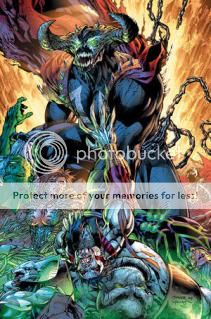
Image United #1
Robert Kirkman, writer
Erik Larsen, Rob Liefeld, Todd McFarlane, Whilce Portacio, Marc Silvestri, Jim Valentino, artists
Image, November 2009
24 pages
$3.99
Wowsers. So, uh, this is a jam comic by six of the seven Image founders, though Jim Lee makes a cameo by providing an alternate cover, which made me smile. It’s about some villains running amok and fighting various heroes for no apparent reason–that’s not my characterization of the plot, that’s the heroes’–which is a pretty fantastic encapsulation of the work of the Image founders to begin with, and certainly their work here. It’s all a moment-to-moment festival of sensation, gritted teeth and punching and blasting and charging the camera, without any kind of prologue or follow-through to place each physical action in any kind of spatial or temporal or emotional context, not even so much as a recap page to catch nostalgic readers up on characters they probably haven’t read since Nirvana was a going concern.
Entrusting layouts to Rob Liefeld (of the six they could have picked from, Liefeld!) could be said to be a mistake, in that characters like the narrator-hero Fortress or the uber-antagonist Omega Spawn burst onto the pages out of nowhere, like they teleported, even though they’re supposed to have been down the block or in the same room, but in light of the above it ends up fitting rather perfectly. At one point the big giant strong hero Badrock [sic] angrily threatens the big giant strong villain Overt-Kill [sic] over an attack we never see on a person who’s not even on panel at the time; later, the long-running Erik Larsen character Savage Dragon, whose appearance in a book filled to the brim with Silvestri and Liefeld creations feels like a walk-on by Glenn Ganges by comparison, remarks “I had no clue the girl took such a hit,” and I had to wonder if this wasn’t Kirkman having some deliberate fun. (I doubt having the arrow-based character Shaft repeat a balloon’s worth of dialogue verbatim two pages apart was deliberate, but wouldn’t it be aweome if it were?)
The most interesting thing about the project is that the artists don’t trade off sections, they draw their own characters whenever they appear, so that you can watch a Jim Valentino hero punch a Todd McFarlane villain, say. The problem with that, though, is that they’re simply not a terribly distinct collection of individual visual stylists. I mean, Larsen’s an exception of course, and Valentino doesn’t look like the rest of the gang but he doesn’t look like much of anything really, and McFarlane might stand out a little in terms of how he choreographs his characters’ physicality but there’s not much of that in this issue, so what you’re left with between Liefeld, Silvestri, Portacio, and McFarlane is a lot of squinty-eyed dudes and dudettes comprised of lots of tiny little lines, standing against generic secret base/rooftop/rubble backgrounds. There’s a manic energy to it, that’s undeniable, but it’s like an album-length guitar solo. It’s all extremely harmless and good-natured–it’s not going to upset you or offend you or leave a bad taste in your mouth, which is saying something–but it’s like being asked for your thoughts on a really rad comic drawn during study hall by the five coolest metalheads in the 9th grade, which not coincidentally is the last time I read comics by most of these guys. It’s all printed on paper stock so shiny it looks like a decade’s worth of gold-embossed chromium glow-in-the-dark holofoil covers were ground up and mixed into the pulp, like KISS’s blood or Mark Gruenwald’s ashes. I think everyone involved, from Kirkman to the Founders to the bulk of the book’s audience, got exactly what they wanted out of it.
Comics Time: High Moon Vol. 1
November 30, 2009
High Moon Vol. 1
David Gallaher, writer
Steve Ellis, artist
DC/Zuda, 2009
192 pages
$14.99
Read the strip at ZudaComics.com
Evolution in action? Here’s a case of the constraints of a comic’s production saddling it with weaknesses, only for the comic to come up with compensatory values that all but overcome them. High Moon is a Western-horror hybrid of the sort very much in vogue over the past few years–what hath Ravenous wrought?–which originally ran in DC Comics’ webcomics portal/competition site Zuda. I believe this necessitated a Sunday-strip-style landscape-format rectangular page, longer than it is tall, as well as a daily-installment delivery mechanism. The storytelling suffers for it all. There’s pretty much one plot beat per panel, with very little breathing room, and moreover nearly every panel contains terse pulp dialogue; the resulting rhythm is staccato to the point of incomprehensibility at times. It doesn’t help that writer David Gallaher’s characters are almost all types, making it even tougher to tell the players at times.
But! Sweet Jesus, look at Steve Ellis’s art. His color palette is a real revelation, fiery oranges and glacial blues all but radiating off the page even despite the book’s rough paper stock. The faces of his hardass outlaws and their lovely ladyfriends come off like a cross between fellow horror artists Terry Moore and Guy Davis, their broad-strokes emotions and intentions easy to parse amid the occasional confusion. I was particularly impressed with his creature designs, admirably ambitious and taking full advantage of Gallaher’s unique, expectation-defying brand of horror-on-the-range. I think I even detected a Robert Williams homage! Ellis’s unnecessarily lovely brushwork really shines in splashpage-style illustrative moments, where you can just sit and stare at the flowing hair and shattered glass and monstrous limbs without feeling propelled to the next rapid-fire panel. It enhances the strengths of Gallaher’s scripting–which include at least one dramatic shift in the story’s direction and an entertaining willingness to throw everything from steampunk to The Crow into the mix–and smooths over some of the weaknesses. Provided you don’t mind when action-horror tilts way way over toward the action end of things, this book is well worth checking out.
Comics Time: Chester 5000 XYV
November 27, 2009
Chester 5000 XYV
Jess Fink, writer/artist
ongoing webcomic, August 2008-November 2009 (and counting)
A steampunk porn webcomic: By god, is this the most Internet-y thing the Internet has ever produced? Regardless, it’s certainly an advertisement for the potential of the web as a publishing mechanism for comics. You can do page after page after page of a cheerful, even sentimental comic drawn in a friendly, loose-fit Craig Thompson-y style (lots of dot-eyes and pointy noses and rapturous swirls) about a woman getting fucked by a robot with a mustache, and Diamond minimums be damned. I stumbled across this by following a link trail from Kate Beaton’s place, which seems somehow appropriate–good luck getting your gag-comic series about historical figures off the ground without a David Finch variant cover, too.
To set the scene: It’s the story of a workaholic Victorian-era scientist who, unable to satisfy his lovely wife’s needs when he’s knee-deep in lab work, builds her, essentially, the world’s most sophisticated vibrator: A humanoid robot who can go-go-go-go and keep the missus busy when the Scientist’s working. Unfortunately for him but fortunately (?) for them, the lady and the robot (the titular Chester) fall in love, as best I can tell because the sex is really awesome and because of Chester’s “programming”–the scientist placed a picture of his wife where the robot’s heart would go. Eventually the Scientist attempts to sell Chester off to a local widow, but Chester has ideas of his own, and this other lovely young lady gets embroiled in the shenanigans, where we’re currently left as of the strip’s latest installment.
My relationship with this comic as I read its year-plus run in one go fluctuated fairly wildly, which surprised me. Now, steampunk’s not really my thing, and the very twee line and look Fink employs generally needs to be shored up by some genuinely meaty content to pass muster with me. Of course, this being a porno comic, there’s a pretty simple way to figure out if it’s working, and work it does. It’s graphic, so there’s that, and there’s a repeated emphasis on clitoral stimulation that all but single-handedly (rimshot!) makes up for the American education system’s sex-ed dropped ball on that score, which has left generations of young men unable to find the thing with a map and a flashlight. (Please change your standards in this regard, Department of Education–the high school girls of America will thank you!) But in addition to all the sensually drawn close-ups of genitalia, Fink has a knack for capturing not just the act, but the desire to act, if you follow me–a look in the lady’s eye as she gets ready to get it on with Chester, the heat-of-the-moment kissing and grabbing and gasping and so on. The build-up to the sequence involving the two women is particularly strong in this regard, though of course I’m a dude with a typical dude’s sensitivities in that area, so, you know, unreliable narrator.
But amid all the cute romance and hot sex and meme-able robot stuff, like I said, there’s some surprisingly tricky terrain. Is the scientist’s obsession with his work really a valid excuse for his wife to so enthusiastically and totally cuckold him–with a gift he gave her, no less? I was pretty sympathetic to the Scientist’s outrage over this–until he took it way too far and flipped my sympathies yet again. When the Widow enters the picture, as much as I enjoyed watching her dive in, I found the notion that, basically, everyone is sexually compatible with everyone…snobbish, in a way? Does that even make sense? But as the four characters are currently coupled off, I feel like we’re seeing adults make a decision about how they really want to live their lives, even though they’re making it with their sex organs at the moment rather then their brains. I don’t know…it’s heady stuff, in its way, and demanding of one’s attention and non-lizard-brain thinking, keeping you actively engaged rather than passively taking in the pretty curved lines and button-pushing romance and dirty drawings. Very interesting.
Comics Time: Just a Man #1, Lost Kisses #9-10, Worms #4, and XO #5
November 25, 2009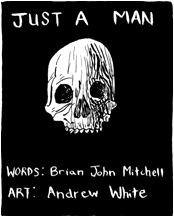
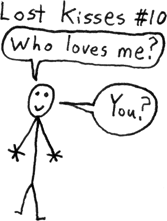 Just a Man #1, Lost Kisses #9-10, Worms #4, and XO #5
Just a Man #1, Lost Kisses #9-10, Worms #4, and XO #5
Brian John Mitchell, writer
Just a Man #1 – Andrew White, artist / 56 pages
Lost Kisses #9 & 10 – Brian John Mitchell, artist / 36 pages each
Worms #4 – Kimberlee Traub, artist / 40 pages
XO #5 – Melissa Spence Gardner, artist / 44 pages
Silber Media, 2009 (I think)
$1 each
Wow, these little suckers put the “mini” in “minicomic.” They’re just under an inch and a half square, limiting the comics they contain to one image-caption pairing per page. It’s an interesting constraint to work impose upon oneself, given that auteur Brian John Mitchell is already up against his own inability to draw. That’s not a subjective assessment, by the way–we’re not talking Jeffrey Brown lo-fi or Brian Chippendale noise or John Porcellino minimalism or Anders Nilsen stick figures or anything else that’s a matter of taste in the Mitchell-drawn Lost Kisses, we’re talking actual stick figures, with little happy-face faces and five even tinier sticks for fingers. Mitchell’s enthusiasm for making comics outstripped his ability to master even its most basic necessities. Which is kinda cute, I’ll admit, and works well enough for the kind of ramshackle navel-gazing confessional humor he’s doing in that particular series, but the air of self-indulgence is unmistakable. Making matters worse is a problem with image flow–I know, hard to believe given that you’re just dealing with one tiny picture and caption on every page. But Mitchell places the drawings on top of the captions even though the drawings respond to what’s said in the captions, so that you either have to read bottom-to-top or constantly spoil the gag for yourself. I have no idea why he does that way–surely he noticed it doesn’t scan? I don’t think it’s a formal innovation done for effect, like Chippendale’s chutes-and-ladders layouts–I just think it’s a mistake.
Which is what makes the other three comics in the envelope Mitchell sent me all the more surprising. Not due to the presence of other artists, mind you–White’s work on Just a Man is scratchily effective, particularly with some effects involving sun glare and flames, but Traub aims for abstraction and ends up coming out just sorta sloppy, while Gardner’s basic cartoony figures look like they came from any number of entry-level webcomics or student-newspaper strips. No, what’s impressive here is how the physical constraints of Mitchell’s tiny format are made to enhance his storytelling. When you have so little room that simply printing a sentence at a legible size eats up half your page, you’ve gotta keep things terse, so why not go hard-boiled and tale tales of murder and mayhem committed by flat-affect protagonists? Just a Man is a Western morality play of violent retribution; a couple of moments overstate the case, I think, but in general it’s a chilling thing, with some memorable facial expressions from White and a surprisingly, refreshingly open and un-cliche ending. XO is a series, but this is apparently the origin story for its blase hitman protagonist, and believe me you didn’t need to know this to appreciate the bracing matter-of-factness with which the character unwittingly but unhesitatingly graduates from selling drugs to eliminating an exceedingly minor threat to that undertaking. Worms is the least effective of the trio–the art just doesn’t do what it wants to do–but the story seems like an engaging enough Cold Heat-style weird-tale sci-fi mindfuck involving a young woman in peril and fighting to break free, and it sure does take a turn for the suddenly brutal at one point. In more assured hands, all three could be really killer melds of form and function. As it stands, they’re maybe not quite there, but if you wanted to spend a measly buck per book, even just to examine what they do right and what they do wrong, you’d have my blessing.
Comics Time: Remake
November 23, 2009
Remake
Lamar Abrams, writer/artist
AdHouse, May 2009
144 pages
$12.95
Buy it from AdHouse for the low low price of $5.95
Look at that cover! Oh man, striking, isn’t it? As a package–with its bold cover image and tight title font and friendly digest size and Powr Mastrs-style bendy cover and Helvetica-heavy title pages–Remake is somethin’ special. As a comic? Mmmm, I’m not quite there with it. What you’ve got here is a gentle superhero parody in the vein of Jeffrey Brown’s Bighead books–or maybe Bighead crossed with Be a Man, since author Lamar Abrams’s target here seems to be the superhero’s propensity for narcissism, destructiveness, and pique. His “hero,” the diminutive boy-robot Max Guy (he’s not named Remake, much to my surprise; hey, why is this book called Remake anyway?) is a blustery, shallow, self-absorbed asshole. He’s prone to sulking, bragging, talking shit, salting game, pigging out, playing video games, befriending his enemies and alienating his allies, breaking the fourth wall, vomiting, and so on. It sounds fun, if that’s the sort of thing you go for. And Abrams’s art helps, though I prefer the uniform line weight, rigid grid, and simplistic designs of the earlier comics collected here to the looser, more Scott Pilgrim-y work toward the back of the book; the earlier material feels like an experiment in staging dramatic, dynamic action and poses while deliberately underselling them with the tools at your disposal, like an 8-bit cover of “Bohemian Rhapsody.” But here’s the thing: It sounds like more fun than it is. Maybe I just got off on the wrong foot with the book, since its first three strips center on homophobia and animal cruelty gags (I know it’s the character, not the author, but still), but I just didn’t laugh a lot at this. There was a funny bit toward the end where Max Guy comes rocketing down from the stratosphere in the middle of a fight to smack his opponent with a pie to the face, and when he’s asked where the pie came from he said that he bought it from a guy selling them on a cloud, and then there’s a jump cut to a little guy with a mustache on a cloud with a stack of pies who says “I’m practically giving them away!”–that made me laugh. The rest, a borderline meh. It’s energetic cartooning, no doubt, and generally importing video-game influences to create something more free-form than conventional action-adventure comics plotting would allow is a good look, but for me it just didn’t cohere into a whole as winning as some of its parts.
Comics Time: Solanin
November 20, 2009
Solanin
Inio Asano, writer/artist
Viz, October 2009
432 pages
$17.99
It’s important not to oversell this book, because author Inio Asano clearly realizes how important it is not to oversell what happens within it. A slice-of-life story involving the amiable but aimless lives of a small group of recently graduated college classmates and the band that alternately provides them with a potential avenue for personal growht and a means of staving off exactly that, Solanin is the Goldilocks of twentysomething pop coming-of-age comics: Not too angsty, not too twee, not too cutesy, not too arch, but just right. The emotions and concerns of its main character, happily unemployed Meiko and her unhappily underemployed boyfriend Taneda, strike me as finely observed and plainly told. The conviction that you must be overestimating your own talent; attempting to fix in someone else a problem present in you as well; the humor-based rhythms of a long-term relationship; the automatic bump upward in feelings of maturity that takes place when living on your own; knowing you must find some direction for your life, yet only really knowing it in the abstract, yet somehow still feeling just as pressured by this as you would if it truly were an immediate matter of life and death; your first real peer-to-peer conversations with your parents; the powerful presence of art and leisure activities, as much of a staple as food and showers; the simultaneously comforting and discomfiting way that life can quickly fill a hole left by trauma or tragedy…it’s all just laid out there, as if all the characters and the author and the audience alike can do is simply take it as it comes. It feels leisurely and true.
Amid the overall high quality proceedings, there are some stand-out moments here, too, from a judicious few playful formal tricks with captions and speech lettering, to a series of kick-ass rocknroll pin-up poses in the Jaime mode that you’ll wanna scan, print, and hang on your wall, to some really fine and sensitive writing surrounding a pivotal plot twist that could easily have thrown the whole project out of whack like an overloaded washing machine. And if the characters are all a bit glamorous-looking compared to their scrupulously realistic plights–beautiful, button-nosed, sloe-eyed women and stylish, bespectacled, well-coiffed men, drawn with the lovely machine-precise slickness I’ve come to associate with the kinds of mainstream manga that find their way to readers like me–well, you know, that’s okay too. It’s fun to watch idealized versions of ourselves beset by the same problems we face. If you liked Gipi’s Garage Band, or the non-fighting parts of Scott Pilgrim, or the non-astronaut parts of Planetes, this one’s for you.
Comics Time: Archaeology
November 18, 2009
Archaeology
James McShane, writer/artist
self-published, September 2009
80 pages
I forget what I paid for it. $10, maybe?
I can’t find anyplace to buy it, but here’s James McShane’s website and blog
Wouldn’t be surprised if it ended up in the Buenaventura Press shop
This thick little minicomic does a lot of things right. First of all there’s the format itself: cardstock pages, folded into a fat little brick, then cut, I believe, with a bandsaw. It’s a delight to hold and let your fingers trace the bumpy edges of the pages; it’s like the anti-newsprint. Then there’s the idea for the concept itself, which won me over the second I figured out what it was: a chronicling of the contents and environs of his childhood home inspired by his mom’s moving out of it. Most of the book is just a shot of a room, a door, a lamp, a tree, a driveway, a hose–one small drawing per page, so intimate I wonder if they were drawn from memory. Flipping through the book’s thick stock ends up feeling like opening a tiny door into this house with each turn of the page. Moreover, McShane glides effortlessly in and out of deviations from the standard operating procedure–there’s a funny sequence of him popping up into the dusty attic and wondering what the heck’s up there (turns out to be nothing); an evocatively minimalist depiction of him and his mom strolling through the neighborhood, juxtaposing little suburban landscapes and still lifes with shots of the pair looking around against a blank background. Finally, McShane sticks the landing with a quietly bravura sequence in which his memories of the house begin to blend together even as he rakes its yard, with a tree suddenly appearing in front of a door and an obviously cherished duck-shaped lamp superimposing itself upon nearly everything, a focal point for years and years of lived experience. McShane’s Porcellino-influenced style is a perfectly breezy and simple complement to this perfectly breezy and simple comic, which nails this specific set of circumstances and sensations just about as well as you could imagine. Very well done.
Comics Time: Follow Me
November 16, 2009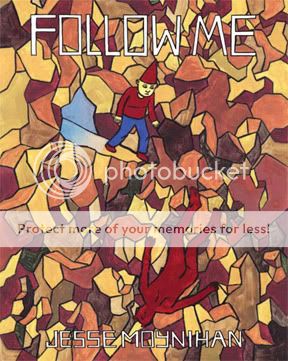
Follow Me (Backwards Folding Mirror #3)
Jesse Moynihan, writer/artist
Bodega, 2009
120 pages
$10
This book’s a tough nut to crack, mostly, I think, because it doesn’t work. There are plenty of familiar altcomix elements present here, from slacker/douchebag observational slice-of-life humor, to gross-out gags and dick jokes and sex comedy, to little fantasy creatures having incongruously realistic and vulgar misadventures, to stream-of-consciousness psychedelic transformations and explorations. All that stuff has been done a million times, and in variations of Moynihan’s knowingly ramshackle black-and-white line to boot–you’ll detect echoes of Matt Furie, Mat Brinkman, Brian Chippendale, Lisa Hanawalt, Alison Cole, Theo Ellsworth, and probably a lot more besides. That said, Follow Me doesn’t feel derivative to me, thanks to Moynihan’s strong, winningly lo-fi character designs and “acting.” His main character, a little dude in a gnome hat, is a pleasure to watch as he’s haplessly buffeted by his own venal impulses and his world’s unpredictable metaphysical freak-outs; he gives Moynihan an opportunity for several standout moments, from his convincingly bewildered look as he gets sucked through a vortex to a goofy little dance he does in which his long shadow effortlessly creates a sense of harsh, bright lighting, a very cool effect.
And yet never does this self-evidently very personal vision burst through the “bubble” of its author’s headspace and communicate its vision of the world to me. I’m sure you don’t need to hear me repeat how much I enjoy comics whose impact is primarily emotional rather than logical, but in such cases I can at least make emotional sense out of what I’m reading due to visual continuity and a tonal through-line, or conversely a tonal juxtaposition,. Here I can do no such thing. Follow Me‘s elements sit awkwardly and uncommunicatively together. I have no idea what the “I can suck my own dick” gags and poop jokes have to do with extended visual riffs on death and multiple planes of existence. And rather than telling an emotional story, the too-frequent, too-abrupt transitions and extended visual extravaganzas just feel like a repeated “and then, and then, and then, and then, and then…” It feels less like daring and more like formlessness. Meanwhile there’s one out-of-nowhere chapter that’s as ill-advised a meditation on race as I’ve seen since David Heatley’s My Brain Is Hanging Upside Down. Much more so than most of the comics that bear the name, this feels like a diary comic, meaning it’s of value primarily to its maker. Which is fine, but caveat lector.
Comics Time: Reykjavik
November 13, 2009
Reykjavik
Henrik Rehr, writer/artist
Fahrenheit, June 2009
48 pages, hardcover
I got it for the low low price of $5 at MoCCA
Buy it from Fahrenheit…? I think?
FOOM! FWOOOSH! KRAKKA-DOOM! Abstract Comics contributor Henrik Rehr’s Fahrenheit is like the purely visual equivalent of a sound effect. Utilizing chops earned through years of more traditional cartooning, Rehr seizes the canvas of abstract comics with a vengeance, crafting a dynamic and frequently stunning–dare I say it?–page-turner, with nary a narrative element to be found.
Rehr is working in pure black and white, reproduced on a slick page stock that gives its expansive visuals a deep and expensive look. His “story” is structured primarily from spread to spread, and in each, one can detect a particular visual inspiration: the whorls of a fingerprint, the activity of unicellular organisms, waves, fire, smoke, a jungle, and in the book’s most memorable moment, a shattered pane of glass. There’s even one spread that looked like ghosts to me, though in that case and all the others, nothing is recognizable as such–Rehr deploys just enough visual cues to get the idea across before riffing off into the stratosphere with them. The emphasis throughout is on motion, with the eye pushed, pulled, and even thrown from one end of the spread to the next by wafting forms, exploding panels, or great ribbonlike curves. At times it looks like nothing so much as the stormy sky of a Dore print blown up to unrecognizable size. The context is gone, but the dynamism removes. This book really puts the “action” back in “abstraction,” and at five bucks–less than most minicomics!–it was an absolute steal. Snag it if you see it at a show.
See a preview below:
Comics Time: Funny Misshapen Body
November 11, 2009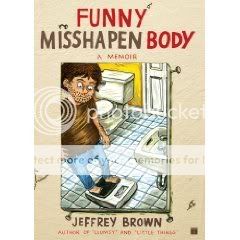
Funny Misshapen Body
Jeffrey Brown, writer/artist
Touchstone, 2009
320 pages
$16
It’s a simple but effective tactic: Jeffrey Brown almost never draws his action straight-on. We see his autobiographical adventures at a three-quarter angle, or from slightly above and behind him, or with cuts to close-ups. When you factor in the seeming rapidity with which his tiny panels flash by, the effect, rather than one of sitting there watching actors, is like peering into a world, the space described with POV shifts and glimpses of corners and floors and rear walls and “extras.” I know I’m sounding like a broken record here–I’ve reviewed a lot of Jeffrey Brown comics and said this sort of thing in most of those reviews–but it just feels necessary to point out as often as possible that there’s a lot more going on, visually, than what’s let on by even the back-cover blurbs of his own books, let alone by people who’ve got a special monogrammed hatchet they break out in his honor.
As is usually the case with Brown’s nonfiction and memoir work, Funny Misshapen Body‘s carefully curated selection of topics and anecdotes belies the surface-level meandering and structurelessness of its narrative. Brown’s basically telling two stories here: the stories of his physical and artistic/intellectual development. That in itself is a revelation, because it’s not like the two intertwine or inform one another in any real way in the segments we see here. But to Brown, clearly his lifelong love of comics, his long and losing struggle to find a fulfilling artistic outlet, and the eureka moment(s) that bridged the two are just as fundamental to his physical existence as his Crohn’s disease, his physical fitness or lack thereof, even going through puberty. (I get the feeling the sex stuff in here would be much more fleshed out if he hadn’t already done several books on the topic.)
Maybe it’s this focus on the basics that enables him to depict the events of his life with such a winning blend of dispassion and good humor. Brown tackles a lot of material here–middle-school bullying, romantic obsessions, creative triumphs and rejections, the onset of sex as a going concern, inebriated and intoxicated collegiate shenanigans–that quite frankly loom on my own personal mental landscape like fucking Stonehenge. It’s almost bizarre to read a memoir that tackles these things from a seemingly undamaged place. But the two parallel narratives complement each other in such a way that it’s quite convincing. Brown’s story is one of seeking a compromise with the demands of his body and seeking no compromise with the demands of his art. He got to the finish line in both cases, and I guess I’d be pretty settled too, then. That it makes for perhaps his best book to date is just gravy.
Comics Time: Refresh, Refresh
November 9, 2009
Refresh, Refresh
Danica Novgorodoff, writer/artist
adapted from the screenplay by James Ponsoldt
based on the short story by Benjamin Pierce
First Second, 2009
144 pages
$17.99
Beware of those epiphanies! They’ll get you every time. Like Novogorodoff’s previous book Slow Storm, Refresh Refresh creaks under the weight of meaning with which every scene is imbued. Every email from its latchkey-kid teenaged protagonist to his soldier father abroad is a poetic reverie about the emptiness of lives touched by war. Every conversation between his friend and his friend’s kid brother is an object lesson in how violence and hierarchical power relationships infect those raised around it. Every bully, every cute girl, every wild animal is a metaphor first and foremost. Once again, there’s a belief-beggaring twist involving violence that dances up to the edge of murderousness in a way that simply doesn’t flow from what has come before, and in this case is actually difficult to parse logistically. And once again, there’s one last desperate night where visions are had and this topsy-turvy world almost makes sense before it all fizzles out and fades away. By the end, I found I didn’t care whether the book’s trio of teen leads ever broke free of the stultifying pressures that were slowly crushing them, but I sure as heck wanted the author to!
That said, one thing that really surprised me about this book was the art. When I saw that Novgorodoff had (with the exception of one key sequence) subbed out her memorable gray watercolor washes for a more traditionally drawn style, complete with acidic colors by hired guns (“Color by Hilary Sycamore and Sky Blue Ink; lead colorist: Alex Campbell”), I shook my head in dismay. Here was the most distinctive thing about Novgorodoff’s earlier book, and now it’s gone? But Novgorodoff’s got the chops for her pencil-and-ink work to stand on its own without the more dramatic painted style supplementing it. It makes for a fluid read, and in such cases as the predatory Army recruiter who intersects with our trio of heroes at several key junctures, it’s a fine conveyor of character information.
I just wish it was being deployed in service of a story a little less beholden to the set-up of literary fiction at its most obligatorily portentous. You know what’s a good point of comparison here? Gipi’s Notes for a War Story. Both are bildungsromane about three teenage boys caught up in the moral, financial, and physical uncertainty of war. Both are drawn in a thin-line style that emphasizes the characters’ awkwardness and vulnerability, but also makes moments of violence that much more impactful. Both are published by First Second. But one feels like a comic, while the other feels like a short story with drawings. Perhaps it’s the “adaptation of an adaptation of a prose short story” set-up that’s the problem, I dunno, but I do know the problem’s there.
Comics Time: Mome Vols. 14-16
November 7, 2009
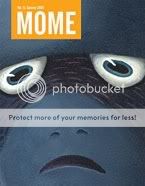

Mome
Vol. 14: Spring 2009–Kaela Graham, Adam Grano, Derek Van Gieson, Laura Park, Olivier Schrauwen, Gilber Shelton, Pic, Dash Shaw, Ray Fenwick, Ben Jones, Frank Santoro, Jon Vermilyea, Sara Edward-Corbett, Conor O’Keefe, Emile Bravo, Lilli Carre, Hernan Migoya, Juaco Vizuete, Josh Simmons, writers/artists
Vol. 15: Summer 2009–Kaela Graham, Andrice Arp, Tim Hensley, Sara Edward-Corbett, Ray Fenwick, Conor O’Keefe, T. Edward Bak, Gilbert Shelton, Pic, Nathan Neal, Noah Van Sciver, Robert Goodin, Dash Shaw, Paul Hornschemeier, Max, writers/artists
Vol. 16: Fall 2009–Kaela Graham, Archer Prewitt, Ted Stearn, Dash Shaw, Lilli Carre, Conor O’Keefe, Ben Jones, Frank Santoro, Jon Vermilyea, Nicholas Mahler, Laura Park, Nate Neal, Renee French, Sara Edward-Corbett, T. Edward Bak, writers/artists
Eric Reynolds, Gary Groth, editors
Fantagraphics, 2009
Vol. 14: 120 pages
Vols. 15-16: 112 pages each
$14.99 each
Things kinda went off the rails here, no?
Like, looking at that list of contributors, you can see some standouts: The Cold Heat material from Jones, Santoro, and Vermilyea is not the strongest Cold Heat material in the world but it’s imaginative and, particularly with Vermilyea at the drawing table, sharply delineated, as is Vermilyea’s delightfully sick solo material. Josh Simmons impresses with his blackly comic strips, particularly a memorable number involving homunculus-sized versions of Tom Cruise and Michael J. Fox grinning soullessly at the assembled paparazzi. Tim Hensley kills it as always with the concluding chapters in his Wally Gropius saga, featuring peerlessly communicated body language perhaps the greatest anti-climax in comics history. I think this is some of the tightest material we’ve seen yet from Sara Edward-Corbett–I love her white-on-black trees and her Ice Haven-esque children-adults. Lilli Carre is alarmingly good at depicting male lust. Nate Neal’s not-so-instant-karma piece in Vol. 16 is explicit and haunting. Dash Shaw is a restless talent, albeit so restless he never seems to settle down even in the middle of any given strip.
But what is Mome at this point? Gone is the “recurring cast” model. Also gone is the Saturday Night Live style approach that replaced it–recurring cast featuring a couple of breakout stars with a celebrity guest each issue. Now it’s just all over the place. Here’s Gilbert Shelton’s unfunny rock epic, here’s Ray Fenwick and Archer Prewitt and Ted Stearn’s unfunny funny-animal things, here’s an astonishingly hamfisted political comic from Emile Bravo, here’s some comics from Spain that are stiff and disjointed, here’s some Conor O’Keefe stuff that’s gorgeously McKay-ian but sort of amorphous, here’s some awkwardly self-referential stuff from Laura Park and Nicholas Mahler, here’s a T. Edward Bak cover version of Dan Simmons’ The Terror and a Renee French piece that just get buried under the accumulated other, lesser contributions. I’m not sure what Mome is supposed to deliver anymore, and I’m not sure how receptive I am to whatever it is delivering.
Comics Time: Captain America: Reborn #4
November 4, 2009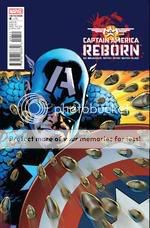
Captain America: Reborn #4
Ed Brubaker, writer
Bryan Hitch, artist
Marvel, November 2009
40 pages
$3.99
In which we learn that Sharon Carter is not just the Billy Pilgriming Captain America’s “constant” in the Lost sense–she’s literally a Cap magnet, pulling him toward her through the timestream thanks to some nanotech in her blood. Ain’t Marvel Universe pseudoscience grand? That’s really all I need to get me over what reservations I had about injecting a time-displacement angle into Brubaker’s years-long top-drawer super-spy saga. And to be fair, the megastoryline kicked off with the Cosmic Cube, the wonkiest of all Marvel’s made-up tech/mystic mumbo jumbo, while one of its best scenes to date involved Bucky’s dismembered cybernetic arm springing to life and taking out a room full of SHIELD goons, so this is not without precedent. (There were some cool giant robots in there too, iirc.)
One of my favorite things about Brubaker’s run–and in this he’s been indispensably assisted by a solid stable of artists, led by Steve Epting and Mike Perkins and stood in for here by the slicker style and cantilevered action of Bryan Hitch, who in every other way is consistent with the established tone–is just how good he is at grouping various super-people together and having those groupings make visual and practical sense. Several times I’ve touted how he’s established this sort of underbelly to the Marvel Universe involving super-powered espionage-based characters: Steve Rogers, Bucky, Black Widow, Union Jack, Crossbones, Agent 13, Nick Fury and so on all look like people you really could believe take advantage of whatever relatively slight super powers they have, put on some form-fitting garb and skullcaps, and go out and assault people in classified military installations. In this issue you see some new combos in that regard, most notably a Bucky-Cap/Black Widow/Ronin trio, who are put through the paces by Hitch in a memorable hit-and-run attack in Marvel’s oft-destroyed Times Square. Elsewhere, Bru and Hitch take a trio of gaudier, more straightforwardly superheroic characters–Mister Fantastic, Hank Pym or whatever he’s calling himself now, and the Vision–and, despite this being the least naturally resonant area of the Marvel U. for Brubaker’s Cap, somehow make them click in that world as a braintrust tasked with cracking the enemy technology that’s brought Cap low.
But the best such scene–the scene that made me want to write the book in the first place–occurs when Homeland Security Commissar Norman “The Green Goblin” Osborn’s right-hand woman Victoria Hand (yup!) drags Sharon Carter, the brainwashed and disgraced Agent 13, in handcuffs into a secret lair. She looks down, and there looking back at her are Doctor Doom, the Red Skull (who’s now trapped in a robot body with a Red Skull mask and an SS uniform), racist luchadore Crossbones, Skull’s S&M daughter Sin, and the torso-themed robot Nazi mad scientist Doctor Arnim Zola. Sharon’s reaction is more bugged-out disbelief than anything else, and it’s entirely appropriate: As assembled by Brubaker, drawn by Hitch, and staged in a clever two-level set-up by the two of them, man oh man does this come across as a batshit-insane crew of lunatics. You really can’t even begin to imagine what kind of crazy horrorshow they’ve got in store for whoever’s unlucky to be dragged into that lab; it’s like the scene in Blue Velvet where Dennis Hopper forces Kyle MacLachlan into Dean Stockwell’s place, only with Doombots and time machines instead of overweight prostitutes and Roy Orbison songs.
And now that I’m writing about it, the scene reminds me in its weird, you-gotta-be-shitting-me way of a very different “here come the bad guys” reveal: that wonderful spread in the first issue of Geoff Johns and Phil Jimenez’s Infinite Crisis where you realize that Uncle Sam and the Freedom Fighters are about to get their collective bell rung by Bizarro, Zoom, Cheetah, Sinestro, Black Adam, Deathstroke, Dr. Light, Psycho-Pirate, and that DC Magneto guy Dr. Polaris–just about as fearsome an array of opposite-numbers and cool power-sets as DC can offer. But while that was prime momentism, this is like anti-momentism–the staging peels back the “whoa” factor and transforms it into a sort of wordless shudder. This is the kind of thing you want every superhero comic you read to be able to deliver.
Comics Time: Pim & Francie
November 2, 2009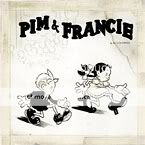
Pim & Francie: The Golden Bear Days
Al Columbia, writer/artist
Fantagraphics, 2009
240 pages, hardcover
$28.99
At SPX this year, a friend of mine approached Al Columbia for a sketch in his themed sketchbook. Columbia started drawing, didn’t like it, tore out the page, crumpled it up. Started drawing again, didn’t like that one either, tore out the page, crumpled it up. Told my friend he couldn’t do it with all the noise and distractions in the room. Stopped drawing sketches for anyone for the rest of the day, except for a tiny circle-dot-dot-curve smiley face next to his signature for anyone who purchased a copy of this book. After I heard this story I told it to a couple of friends. One remarked that if he’d been forced to concoct a story about what trying to get a sketch from Al Columbia would be like, this would have been it. Another said he’d agree with that assessment, but only if Columbia had been paid for the work first.
Al Columbia may be the closest alternative comics has come to producing a Syd Barrett, an Axl Rose, a Sly Stone, a Kevin Shields, a sandbox-era Brian Wilson, or heck, a Steve Ditko–a prodigious, world-beating talent chased off stage by his own…ugh, I don’t want to say demons, but even if you ascribe Columbia’s Big Numbers flameout and lack of published work post-Biologic Show to perfectionism, surely perfectionism that total and unforgiving is a demon of a kind.
The genius of Pim & Francie is harnessing the power of that demon–whatever it is or was that led Columbia to abandon his impossibly immaculate conceptions of monstrousness and murder half-drawn on the page time and time again–and deploying it as a conscious aesthetic decision. Reproducing unfinished roughs, penciled-in and scribbled-out dialogue, half-inked panels, torn-up and taped-together pages, even cropping what look like finished comics so that you can’t see the whole thing, Columbia and his partners in the production of this book, Paul Baresh and Adam Grano, have produced a fractured masterpiece, a glimpse of the forbidden, an objet d’art noir. As I wrote on Robot 6 the other day:
my favorite thing about Columbia’s comics–many of which can now be found in his new Fantagraphics hardcover Pim and Francie–is how they look like the product of some doomed and demented animation studio. It’s as though a team of expert craftsmen became trapped in their office sometime during the Depression and were forgotten about for decades, reduced to inbreeding, feeding on their own dead, and making human sacrifices to the mimeograph machine, and when the authorities finally stumbled across their charnel-house lair, this stuff is what they were working on in the darkness.
The horror of Columbia’s sickly-cute Pim & Francie vignettes–a zombie story, a serial-killer story, a witch-in-the-woods story, a haunted-forest story, a trio of chase sequences–is extraordinarily effective. And the stand-alone images both inside and outside those stories–the Beast of the Apocalypse as story-book fawn, a field of horrid man-things staring right at you, a broken-down theme park and the phrase “there’s something wrong with grandpa,” a forest of crying trees, some dreadful being of black flame running full-tilt down the basement stairs, zombie Grandma stopping her dishwashing and glancing up toward where the children sleep–are as close as comics have come (hate to keep using that formulation, but there you have it) to the girls at the end of the hall in The Shining, the chalk-white face of the demon flashing at us in Father Karras’s dream in The Exorcist, the inscrutable motionlessness of characters in The Blair Witch Project and Paranormal Activity. The craft involved in their creation is simply remarkable, with Columbia’s assuredness of line, faux-vintage aesthetic, and near-peerless use of blacks all actually gaining from his panels’ frequent extreme-close-up enlargement throughout the collection.
But moreover, these scary stories and disturbing images are all so gorgeously awful that they appear to have corrupted the book itself. They look like they’ve emerged from the ether, seared or stained themselves partly onto the pages, then burned out, or been extinguished when the nominal author shut his sketchbook and hurled it across the room or tore up the pages in terror. It’s comic book as Samara’s video from The Ring, Lemarchand’s box from Hellraiser, Abdul Alhazred’s Necronomicon from Lovecraft, the titular toy from Stephen King’s “The Monkey”–an inherently horrific object. Bravo.
Not Comics Time: Portable Grindhouse: The Lost Art of the VHS Box
October 30, 2009
Portable Grindhouse: The Lost Art of the VHS Box
Jacques Boyreau, editor
Fantagraphics, 2009
200 pages, slipcover
$19.99
Buy it from Fantagraphics, eventually
Buy it from Amazon.com eventually too
My entire circle of friends has been clamoring for this long-delayed collection of video box art for over a year–and could this be any more in my wheelhouse right now? If you made a Venn diagram out of the New Action, the Manly Movie Mamajama, and everything I talk about it that Dark Knight Strikes Again review, you’d find this right in the sweet spot. Even if this book didn’t exist, it would be necessary for me to invent it.
So let’s start by talking about what I didn’t like about it. Well, “didn’t like” is probably too strong–it’s fine, just not what I was looking for–but I couldn’t help but be let down by editor and compiler Jacques Boyreau’s introduction. You get a brief sketch of his personal history with home video, a lengthy technical history of the format, and a diatribe about the evils of digital. Actual discussion of “the lost art of the VHS box” is reserved for an interesting but meager two-paragraph rumination on the way their display in video stores made them the iconic equivalent of the films they contained, but this quickly gives way to one last swipe at DVDs, downloads, and digital projection. Nothing about any of the artists or designers involved, nothing about the evolving aesthetics of box art as home video went became a megabusiness, nothing about any of the covers on the pages that follow. If you’re looking for information about the business and creative decisions that led to the creation of this childhood-memory art form, you’ll come away disappointed.
But if you’re simply looking for a gallery of those memories and beyond, Boyreau did you right. He and designer Jacob Covery wisely chose to present the front cover of every box in the context of a product shot, rather than simply scanning the art and running it full-bleed–he’s absolutely right to argue that these images are inseparable from their status as objects. The box shots of the front cover (and spine) occupy the right-hand side of every spread, while the left-hand side reproduces the back cover. And here they do scan it and run it full-bleed, which actually just makes it funnier. Why? Well, it was clear from the start that what you needed to do with the front of your VHS box was make the image as lurid and eye-catching as possible, so there are surprisingly few variations in that regard beyond obvious budget and talent limitations in some cases. But what to do with the back cover? For a long time, no one seemed to know. The familiar tagline/teaser blurb/stills/credits framework was far from universal, and in its place were long lists of other movies released on home video by the studio (on the back of Vanishing Point, Magnetic Video Corporation listed fully fifty-eight), terse flat-affect plot summaries (The Chamber of Fear‘s blurb begins “The crevice of the volcano is very deep. Scientists are searching for a form of underground life that according to theory still exists.”), poorly written catalogues of the depraved behavior contained inside (Blood Spattered Bride notes “Although not rated this film contains nudity and scenes of graphic violence”), and in one memorable case (The Best of Burlesque–somehow I doubt it!) just a flipped and blown-up segment of the front cover’s airbrushed T&A illustration. Seeing all this proto-professional weirdness on the page normally reserved for placing the image next to it in some sort of factual context is hilarious.
But let’s face it, you’re here for the front covers, and they don’t disappoint. You’ve got titles like Drive-In Massacre, Don’t Go In the House, and Slave Girls from Beyond Infinity. You’ve got taglines like Video Violence‘s “…When renting is not enough!!”, Slashdance‘s “SAVE THE LAST DANCE…FOR HELL!” and The Lift‘s “TAKE THE STAIRS, TAKE THE STAIRS. FOR GOD’S SAKE TAKE THE STAIRS!!!” You’ve got images you likely remember from the scary sections of your local mom-and-pop video shop–the girl-gun of Master Blaster, the knife-through-the mask of Friday the 13th: The Final Chapter (the back-cover blurb appends a question mark to that increasingly inaccurate adjective, by the way), and the genuinely striking redneck cheesecake of ‘Gator Bait. You’ve got bloody knives, Giger knock-offs, urban warriors, and underboob.
As is probably clear by now (if it wasn’t already from the book’s title), the bulk of these boxes are for B-movie genre pictures. The exceptions are therefore often all the more interesting. Go Hog Wild is a glorious example of a truly lost art, the cartooned/painted high-school sex comedy poster. Barbie and the Rockers: Out of this World, with a 1987 copyright date, demonstrates the by-then astonishing moneymaking potential of the medium–a full rental fee for one 25-minute cartoon! The box-art design for Sidney Lumet’s Network, though crude by today’s standards, provides a representative look at the far classier approach to A-list studio affairs.
Most anomalous of all are the non-fiction efforts. A Johnny Bench documentary stands out for its blandness, while the Unknown Comic’s bag-clad noggin and overall awfulness could, with a little tweaking, fit right in with the various monsters and slashers. There’s a Gulf War I cash-in from ABC News, simply repackaging a military briefing from Norman Schwarzkopf. Grossest of all is an obliviously bloodthirsty hunting documentary called Bowhunting Whitetails: Just for Fun!: A grinning hunter holds a dead deer’s head by the antlers on the front, the back-cover copy revels in the hunter’s triumph over the poor stupid unarmed animal he slaughters, and there’s a tagline advertising “5 Vivid Arrow Impacts!” Even more than hilariously inept stuff like the Lon Chaney/John Carradine vehicle Alien Massacre and its crosseyed cover babe, it’s these documentaries and hobbyist videos that show just how widely the doors were thrown open to media producers and consumers of all stripes by the home video revolution.
And believe it or not, a couple of the covers even succeed as art! Boyreau smartly puts the two that do best right next to each other–the jagged ’80s splash-of-paint surrealism for the euro-slasher Eyeball (featuring an extremely rare artist credit, for illustrator Dick Bouchard) and the striking still of a loincloth-clad Cornel Wilde running from his life from spear-chucking African natives that bedecked the colonialist adventure The Naked Pray. Elsewhere, the bold two-color art for Walter Hill’s rock’n’roll fantasia Streets of Fire is ripe for reinterpretation today, I’d say; it’s easy to picture a Scott Pilgrim promotional piece riffing on its look and pose. And did I mention ‘Gator Bait? Step it up, Terry Richardson!
Now here’s the thing: A little Google Fu and you could probably come up with jpgs of nearly all the titles I’ve mentioned, and more besides. Boyreau laments how digital phased out analog when it comes to our movie viewing; has the Internet done the same with his book commemorating the losing side of that battle? I say no. It’s not just because of the tremendous job Boyreau and Covey did with the cover reproductions, or the lovely, solid paper stock, or the cutesy slipcase. It’s because Boyreau is right: the aura of the object is irreplaceable. A book collection of VHS box art contains preserves what was special about them in a way a Flickr gallery just can’t. Next time you have a trashy movie marathon, pass this around between movies–unlike your laptop, you won’t even need to worry that much about spilling beer on it.
Comics Time: The Dark Knight Strikes Again
October 29, 2009
The Dark Knight Strikes Again
Frank Miller, writer
Frank Miller & Lynn Varley, artists
DC, 2003
256 pages
$19.99
For today’s Comics Time review, please visit The Savage Critic(s).
Comics Time: Dark Reign: The List #7–Wolverine
October 28, 2009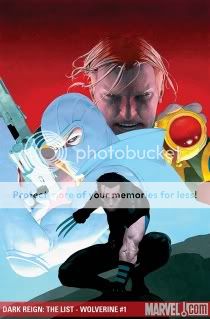
Dark Reign: The List #7–Wolverine
Jason Aaron, writer
Esad Ribic, artist
Marvel, October 2009
48 pages
$3.99
Well well well, looks like Marvel decided maybe they should have strained that Grant Morrison bathwater for babies before they threw it all out. Yeah, Joss Whedon (and, in those nobly intentioned but ill-conceived Phoenix minis, Greg Pak) got to nod in New X-Men‘s direction now and then–Cassandra Nova, a one-line reference to Magneto’s trashing of Manhattan, even the Bug Room. But other than wiping out Genosha, killing Jean Grey, and establishing Emma Frost as the X-Men’s new HBIC, Marvel basically ran, not walked, away from Morrison’s ideas and tone alike. (Exhibit A: that Xorn arc from New Avengers.) So writer Jason Aaron’s full-fledged Morrison Marvel Team-Up in this very very central event title, pitting Wolverine, Marvel Boy (!), and Fantomex (!!!) against Norman Osborn for the fate of The World (i.e. the Morrison-created birthplace of the Weapon Plus program that spawned everyone from Captain America to the ol’ Canucklehead), is something of a turning point. Certainly I didn’t expect to see a French-accented international man of mystery playing a role in Dark Reign, except perhaps as someone for Ares to chop in half in a throwaway sequence in Dark Avengers.
What’s impressive about this is that rather than try to ape high Morrisonian “mad ideas” (except for a played-for-laughs viral-religion thing), Aaron riffs on an entirely different Morrison tone: cheeky high-concept comedy. Instead of writing Marvel Boy as some sort of brooding military brat, Aaron returns him to the quasi-Clockwork Orange blend of arrogance, ultraviolence, and killer good looks that made his original Morrison miniseries such a hoot. He’s like Chuck Bass with insect DNA. (Okay, more insect DNA.) Similarly, Fantomex is treated as a charming rogue with a cool white uniform rather than Aaron simply waving his hands in the face of his weird power set and Frenchness and giving up or phoning in some black-ops boilerplate. Wolverine actually plays a supporting role more than anything else, but when he’s unleashed, it’s in a splatstick fashion consistent with the joli-laid physicality Morrison’s collaborator Frank Quitely imbued him with. Ribic’s art goes a long way in this regard–I’d previously known him only for his admittedly dynamic Alex Ross-indebted painted work, but his pencils have a cartoony zest that would be right at home on some three-issue Vertigo miniseries.
What does it all mean in the context of Dark Reign and The List and so on? As best I can tell, not much. But reintegrating Morrison’s many toys into the mainstream Marvel Universe, as opposed to the province of editorially hands-off limited series, is pretty momentous in and of itself. Fingers crossed we’ll see the Phoenix Corps again when all is said and done.
Comics Time: nothin’
October 26, 2009Today’s Comics Time review has been canceled because I accidentally read and reviewed a book that’s embargoed until Wednesday. I am a doofus. Comics Time will resume on Wednesday, and I may throw in an extra review at some point this week just to make up for this. You never know.

